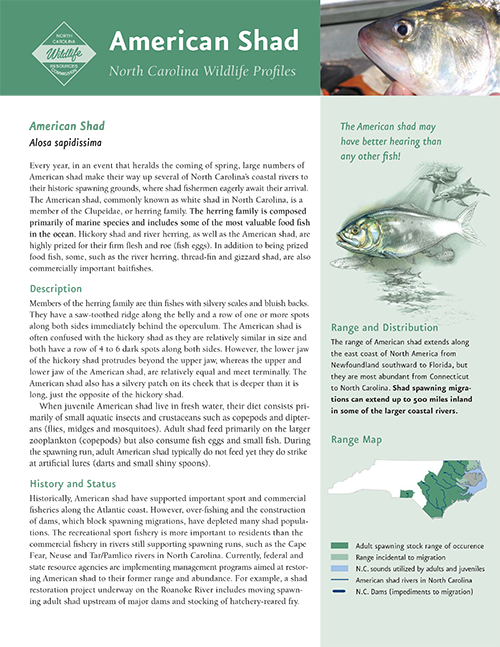Curriculum
Science 1.10, 3.02, 3.03, 3.04, 3.08, Language Arts 2.01, 3.02, 4.01
Purpose
Students will understand complexity and connectivity within a near shore marine ecosystem by learning the story of the American shad, creating a food web, and identifying specific reasons for their decline as well as restoration practices that can help bring them back into the ecosystem.
Duration
45 minutes to one hour
Materials
- Set of Food Web Cards (1 per group of students) (PDF, external link)
- Attachment 1 - Food Web Activity sheet (1 per student) (PDF, external link)
- Attachment 2 - "American shad" profile sheet (1 per student) (PDF, external link)
- Attachment 3 "Profile of a Biologist" (1 per student) (PDF, external link)
- Food Web Key (optional to hand out at the end of the activity to each student, or group for use in their own assessment of their work (you would need a class set, or 1 per group), or for use for your assessment (PDF, external link)
- Food Chain Key (optional for use in giving to students before they build the food webs as a review (1per group) during the activity, or for assessment purposes at the end of the activity (print one for yourself) (PDF, external link)
- Glue
- Poster board or other large piece of paper to glue food webs on
- Scissors for each student group
- Colored markers or crayons can be used if needed or wanted.
Directions
- Give each student a copy of the food web activity student sheet (Attachment 1), the "American Shad" profile (Attachment 2) and the "Profile of a Biologist" (Attachment 3).
- Have students read the articles and answer the questions on the food web activity student sheet.
- After students read the articles and answer the questions, break the students into small groups to do the food web card game.
- Hand out a set of "Food Web Cards" to each group. Have student groups build their food web charts and glue them in place on poster board, or on a large piece of paper. Should students need a review, you could hand out the Food Chain Key to groups. (Students can use the McDougal Littel "Science" textbook, page 127, as a reference.) Have students write the names of all group members on their poster.
- After students have finished their food webs, you have the option of handing out the "Food Web Key" and/or the "Food Chain Key" to students to check their own work.
- Display the posters around the room.
Extension Activities
- Post your food webs outside of your classroom to educate other students about your shad project and the role of shad in the ecosystem.
- Do further research on all of the organisms and/or animals in the food web and do a food web chart that has more information on each, complete with real pictures of animals in their habitats.
- Do research to determine what other animals, such as Bald Eagles, depend on American shad either directly or indirectly and add these animals to make an expanded food web. Bald Eagles evolved to raise their young when anadromous fish such as American shad are returning to spawn. Bald Eagles are interesting to research and can be seen on many live web cams around the country. View live Bald Eagles nesting at Blackwater National Wildlife Refuge and see how many herring they bring into their nest for food. (external link)
Extra Reading: Read the top paragraph on page 122 the McDougal Littel "Science" textbook on near shore waters. Then review page 126-7, on the Surface Zone and the diagram of the "Life in the Open Ocean." Many of the plants and animals shown in the "Life in the Open Ocean" also exist in the food chains of near shore waters. Reading through this information will help you to understand food webs.
Additional Resources
- Response of American Shad and Striped Bass to Removal of Quaker Neck Dam
- Restoring American Shad on the Roanoke River One Fish at a time


